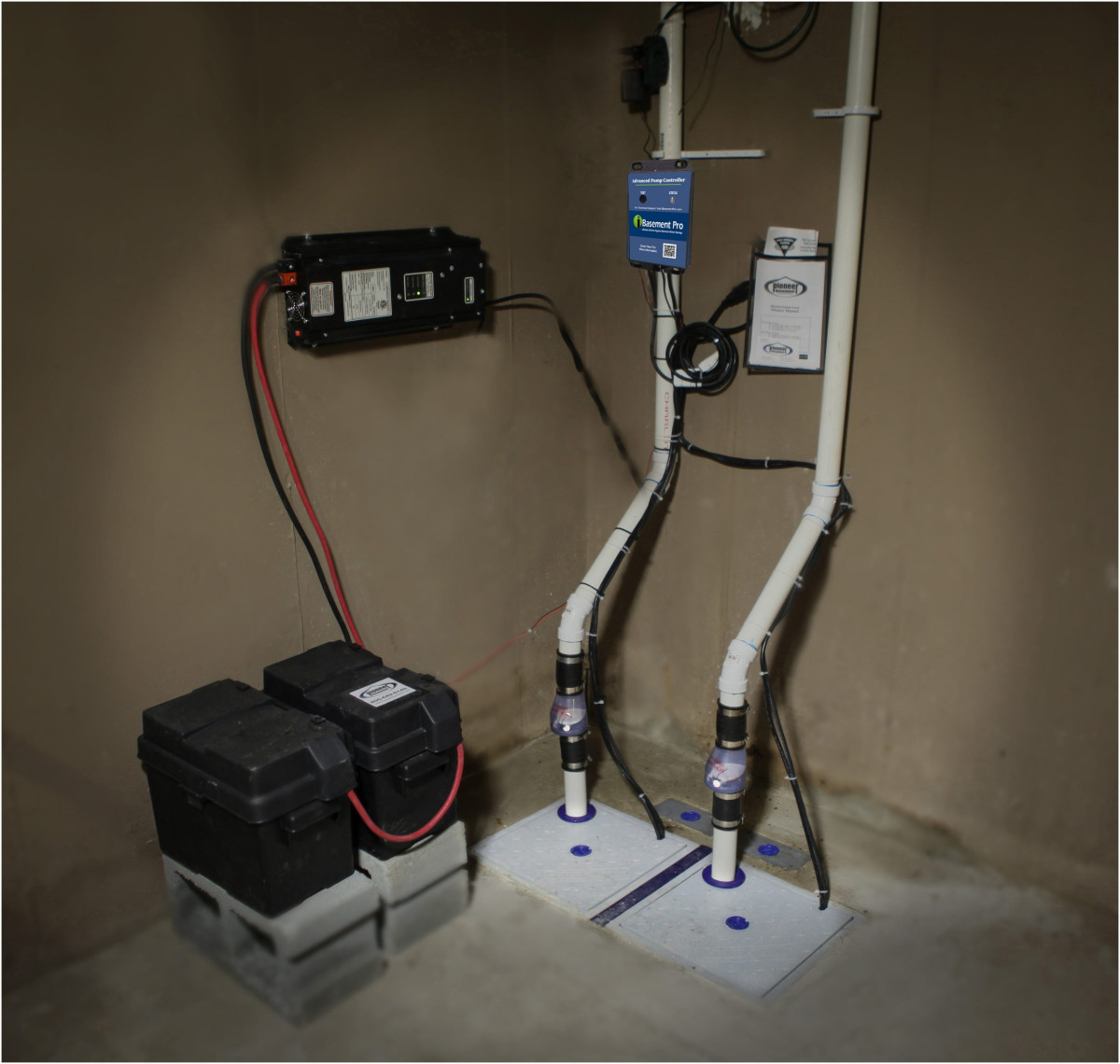Ever been startled by the sudden realization of a flooded basement? You’re not alone. It’s a common issue, especially in areas prone to heavy rainfall or if your home’s foundation is below the water table. Enter the sump pump – a homeowner’s best defense against basement flooding. This ingenious device works tirelessly to keep your basement dry, but how exactly does it accomplish this? And what steps can you take to guarantee its peak performance? Let’s explore the answers together, and you might just find that a sump pump is your basement’s unsung hero.
Understanding the Basics of Sump Pumps
Diving into the world of sump pumps can initially seem overwhelming, but breaking it down makes it manageable.
 You see, a sump pump is fundamentally a device that’s installed in the lowest part of your basement or crawlspace. Its primary job? To keep the area under your house dry and prevent it from flooding.
You see, a sump pump is fundamentally a device that’s installed in the lowest part of your basement or crawlspace. Its primary job? To keep the area under your house dry and prevent it from flooding.
Sounds simple, right? Well, the intricacies lie in how it accomplishes this task. The sump pump is usually situated in a specially constructed sump pit. Water flows into this pit either through drains or natural water migration through the soil. The pump’s job is to pump the water out of the pit and away from your home so the basement or crawlspace stays dry.
There are two types of sump pumps: submersible and pedestal. A submersible pump is entirely enclosed in the sump pit, while a pedestal pump’s motor is outside the pit.
You’ll need to decide which is best suited for your home. This decision will depend on factors like your sump pit’s size and how much water you typically need to remove.
Keep in mind, we’re not delving into why basements get wet here. That’s a topic for another time.
The Importance of Sump Pumps
Your basement’s integrity heavily depends on a sump pump. This device is the heart of your basement waterproofing system. When unwanted water makes its way into your basement, the sump pump’s job is to send it packing. It’s installed in a sump pit at the lowest part of your basement or crawl space. From there, it pumps out water that collects in the pit, thereby preventing it from flooding your basement.
You may be thinking, “Why is this so important?” Well, for starters, it protects your home from water damage, which can be costly to repair. It also prevents the growth of mold and mildew, which can lead to health problems. Additionally, it safeguards your belongings stored in the basement from water damage.
But that’s not all. A well-functioning sump pump increases the value of your home. Potential homebuyers would be more willing to purchase a house with a dry, well-maintained basement.
It’s crucial to keep your sump pump in peak condition to guarantee it can do its job when needed. So, remember, a sump pump isn’t just a device; it’s an investment in your home’s future.
Different Types of Sump Pumps
Now, let’s move on to the different types of sump pumps.
You need to understand the features of primary sump pumps, as they’re the most commonly used.
We’ll also shed light on battery-backup sump pumps which can be of immense help during power outages.
Understanding Primary Sump Pumps
Nestled deep in the heart of your home’s foundation, primary sump pumps serve as silent guardians against water damage. They’re the main defense, tirelessly working to keep your basement dry at all times.
Most homeowners are oblivious to the existence of these essential devices until a significant issue arises. Don’t be one of them. Understanding the functioning of these appliances will equip you to prevent potential water damages.
Primary sump pumps are electric-powered and typically installed in a sump pit at the lowest point in your basement. They operate on a simple mechanism: as groundwater level rises, it triggers a float switch, activating the pump. This water is then displaced safely away from your home’s foundation.
There are two types of primary sump pumps – submersible and pedestal. Submersible pumps are encased within the sump pit, staying out of sight and sound. They’re ideal for finished basements.
On the other hand, pedestal pumps have their motor outside the pit, making them more noticeable but easier to service.
Battery-Backup Sump Pumps Explained
In the domain of home protection, battery-backup sump pumps are your unsung heroes, providing an additional layer of defense against water damage.
They’re specially designed to kick in when your primary sump pump fails due to power outage, malfunctions, or overwhelming water volume.
A battery-backup sump pump has its own separate power source, typically a 12-volt deep-cycle marine battery.
It’s wired to an alarm system to alert you when it’s activated, so you’re never caught off guard.
The battery lasts for several hours, providing continuous water removal even during prolonged power outages.
When considering a battery-backup sump pump, it’s crucial to note its pumping capacity.
You’ll want one that can handle the same amount of water, or close to it, as your primary pump.
Also, make sure the battery is maintenance-free and automatically recharges when power is restored.
How Sump Pumps Work
Understanding how sump pumps work can help you better maintain your basement’s water management system. They’re not as complicated as you might think. Fundamentally, a sump pump’s role is to collect and divert water from your basement to keep it dry and prevent water damage.
Sump pumps are installed in a pit or basin, usually located at the lowest point of your basement. When water enters your basement, it automatically flows into this pit due to gravity. The pump is triggered by a float switch that rises as the water level in the pit increases. Once the water reaches a certain level, the pump starts working.
The sump pump then uses its motor to propel the water out of the pit through a discharge pipe. A check valve at the end of the pipe prevents the water from flowing back into the pit.
Your sump pump is constantly working to keep your basement dry, even when it’s not raining, by dealing with the water that naturally seeps into your basement from the surrounding soil.
That’s the basic mechanism of how a sump pump works. Understanding this can greatly assist in its maintenance and longevity.
Installation Process for Sump Pumps
Now that you’ve grasped how sump pumps work, it’s time to tackle the installation process.
The first step is selecting the right pump for your basement’s specific needs.
After that, we’ll walk you through the necessary tools you’ll need and provide a detailed, step-by-step guide to guarantee your installation is a success.
Choosing the Right Pump
Before delving into the installation process, it’s crucial to pick the right sump pump for your basement. With a myriad of types and models, it can feel overwhelming. But don’t worry, we’re here to assist you.
 Firstly, consider your basement’s size and the volume of water it typically accumulates. A small, compact pump might suffice for a smaller space with low moisture levels, while larger basements with higher moisture levels may need a more robust system.
Firstly, consider your basement’s size and the volume of water it typically accumulates. A small, compact pump might suffice for a smaller space with low moisture levels, while larger basements with higher moisture levels may need a more robust system.
Secondly, check out the power source options. If you’re often plagued by power outages, a battery-operated pump could be your saving grace. Alternatively, you might prefer a direct electrical connection for a continuous power supply.
Thirdly, think about the pump’s switch type. Tethered float switches provide a larger pumping range, while vertical float switches are better suited for narrow sump pits.
Lastly, consider the pump’s materials. Cast iron pumps may be pricier, but they’re more durable and dissipate heat better than plastic models.
Necessary Installation Tools
Equipping yourself with the right tools is an essential step in the sump pump installation process. Before you start, you’ll need a good pair of rubber gloves for safety, as you’ll be dealing with water and electricity. A sturdy shovel will be necessary for digging the sump pit. A hacksaw or a reciprocating saw will be vital for cutting the PVC pipe to the correct length.
A level is important to guarantee the pump and piping are installed straight and correctly. A drill with a masonry bit will make quick work of creating holes for your discharge pipe. Don’t forget a set of wrenches for tightening bolts, and a good pair of pliers for securing the hose clamp.
You’ll also need a check valve to prevent water from flowing back into the sump pit, and a good quality PVC cement for sealing the pipe joints. A tape measure will assure accurate measurements, while a torque wrench can confirm the right level of tightness for each bolt.
Lastly, remember a bucket and rags for any cleanup. With these tools at your disposal, you’ll be well-prepared for the installation. Be sure to gather every item before you start.
Sump Pump Maintenance Tips
Without regular maintenance, your sump pump could stop working just when you need it most. It’s crucial to test your pump every three to four months. Start by pouring a bucket of water into the sump pit. The pump should turn on, remove the water, and then automatically shut off.
You should also clean the sump pit annually. Remove any debris that could block the pump’s intake screen. Sediment build-up can decrease the pump’s efficiency, so it’s vital to keep it clean.
The float component of your sump pump is critical. It triggers the pump to start working when water reaches a certain level. Make sure it isn’t obstructed and moves freely.
Check the discharge line for any blockages. A clogged discharge line could prevent water from exiting the pump, leading to overflowing.
Lastly, every couple of years, consider hiring a professional to give your sump pump a thorough inspection. They’ll check for wear and tear, faulty wiring, or other potential issues that mightn’t be visible to the untrained eye.
Regular maintenance guarantees your sump pump works effectively, keeping your basement dry and your home safe.
Common Issues With Sump Pumps
Despite your best efforts in maintaining your sump pump, problems can still arise due to various reasons. One common issue you might encounter is a pump that’s running non-stop. This could be due to a switch problem, a check valve failure, or even because the pump’s capacity is too small for the amount of water it needs to handle.
Another prevalent problem is power failure. Sump pumps are electric, so during a power outage, they’ll stop working unless there’s a backup system in place. A battery-powered backup sump pump or a generator can help you avoid this issue.
Clogged or frozen discharge lines can also wreak havoc with your sump pump’s operation. Regular inspection and cleaning of the discharge lines, as well as protection against freezing, can keep this problem at bay.
Lastly, you might face an issue with the sump pit. If it’s too small or shallow, it won’t hold enough water for the pump to switch on. Conversely, if it’s too large, the pump will work harder than necessary, shortening its lifespan.
Verify your sump pit is appropriately sized for your pump’s capacity.
Choosing the Right Sump Pump
When it comes to choosing the right sump pump for your basement, several key factors come into play.
First, you’ll need to take into account the type of pump. Submersible pumps sit in the water in a sump pit, while pedestal pumps are mounted above the pit. Submersibles tend to be quieter and more efficient but are also more expensive. Pedestal pumps, on the other hand, are cheaper and easier to maintain, but they’re not as powerful.
Next, evaluate the pump’s horsepower. A 1/3 horsepower pump is suitable for most homes, but if you’ve got a significant amount of water to move, you might be better off with a 1/2 horsepower model.
Thirdly, look at the pump’s capacity – how many gallons of water it can move per minute. This should be clearly stated on the pump’s specifications.
Lastly, don’t forget to check the pump’s switch mechanism. Vertical switches are more reliable, but they require a wider sump pit. Tethered switches, however, can handle higher capacities but are less reliable.
Selecting the right sump pump is essential to keeping your basement dry. Choose wisely!
Professional Sump Pump Services
After you’ve chosen the right sump pump, you might find that installing and maintaining it can be a complex task. This is where professional sump pump services come in. These experts have the technical knowledge and practical experience to guarantee that your pump is installed correctly and runs efficiently.
One key service is sump pump installation. This involves not just physically placing the pump, but also confirming it’s correctly connected to your home’s plumbing and electrical systems. It also includes creating a discharge line to carry water away from your home, and a check valve to prevent backflow.
Maintenance services are another vital aspect. Regular check-ups can detect potential issues before they become bigger, more expensive problems. Pros will inspect the pump, cleaning it and replacing worn parts as needed. They’ll also test it to verify it’s working correctly, which can be a lifesaver in a heavy storm.
So, there you have it, folks! With the right sump pump, your basement can be as dry as a desert. They’re the unsung heroes of home maintenance, tirelessly working to protect your property from water damage. But remember, even the mightiest sump pump needs regular care to keep doing its job. Don’t underestimate the power of routine maintenance—it’s the key to a dry, flood-free basement. Choose wisely, maintain regularly, and your sump pump will never let you down.



